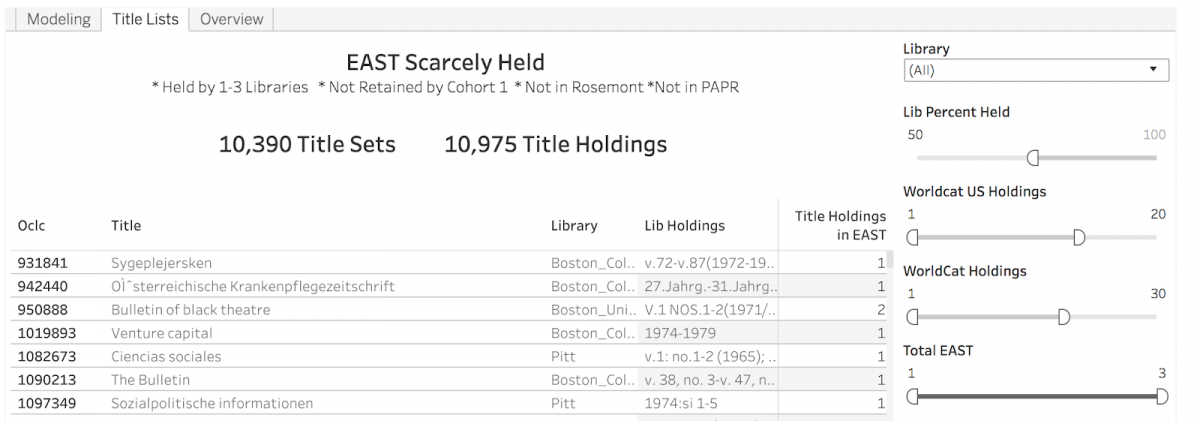In late 2025, EAST began undertaking another round of collection analysis focussed on serial and journals. Sixty (60) EAST members have opted to participate in this project. This work is being supported by the collection comparison service of the Center for Research Libraries (CRL) and the work of the EAST Serials and Journals Working Group. One of the main goals of the project is to identify additional titles appropriate for EAST retention and also reexamine titles previously committed to EAST during the collection analysis work carried out from 2017-2019. This previous project resulted in 32 EAST Serials and Journal Retention Partners collectively agreeing to retain approximately 25,000 print journal titles with approximately 37,000 holdings for a minimum of 15-years. This work was also supported by CRL.
History and Process - 2017-2019
From 2017-2019, EAST took a phased approach to collection analysis, focusing first on developing retention rules for titles held by 4-6 participating libraries. Followed by subsequent analyses of more widely-held titles, those held by 7-28 participating libraries, and finally those titles held by 3 or fewer participating libraries. Details of these processes can be found in the EAST Serials & Journals Collection Analysis and Retention Modeling 2016-2019 document.
The EAST Serials and Journals Working Group considered a number of different retention factors including: holdings overlap, subjects, languages, electronic availability, OCLC WorldCat holdings, availability in JSTOR, format, and retention commitments from other shared print programs. This data was loaded into the visualization software Tableau to assist the Working Group in analyzing the plethora of data provided.
This graphic is a visualization from Tableau showing the characteristics of the scarcely held titles, those held by only 1-3 EAST libraries. On the left is a breakdown of the titles by LC class, showing that the H class has the largest number of titles – this is consistent with the first two categories of serials and journals titles we analyzed.

The pie chart at the bottom right indicates the languages found in this set of over 29,500 titles with English clearly predominating as has been the case with our earlier data.
The middle bar chart on the right shows that some 65% of the titles in this scarcely held category were held by only ONE EAST library – we consistently found higher rates of uniqueness across serials and journals than we had with our monograph work. The top bar chart on the right shows a distribution by year of publication.
And finally the bar chart on the bottom right indicates the depth of holdings across this set of titles – with about 50% of the titles holding more than half of the full run. This final data was very useful to us as we developed our retention model for the scarcely held titles.
Project Scope - 2017-2019
Across the three phases of retention work EAST libraries agreed to:
- Retain up to 3 copies of each title eligible for retention;
- Have the 3 libraries with the deepest run of a title allocated retention responsibility;
- Exclude titles with Rosemont Alliance for Shared Print retention commitments.
The following materials were also excluded from retention consideration and were considered out of scope:
- Reference works
- Non-print format
- Guides
- Indexes
- Monographic series
- Directories
- Government documents
- Loose leaf reference work
- Newspapers
- Almanacs
- JSTOR titles
- Fact books
- Handbooks
- Yearbooks
Additionally, for the “Scarce” category of titles (those held by 3 or fewer EAST libraries) we also agreed that:
- A library needed to hold at least 50% of the run in order to be assigned a retention commitment;
- Only titles where US WorldCat holdings were fewer than 20 and worldwide WorldCat holdings were fewer than 30 were retained.
These rules are shown applied in this visual from Tableau:

CRL applied these retention rules to the collective collection and allocated retention responsibility to individual libraries. Libraries were then provided with an opportunity to review the retention proposals and optionally validate physical volumes, identify holdings errors, and any titles they were unwilling or unable to retain.
